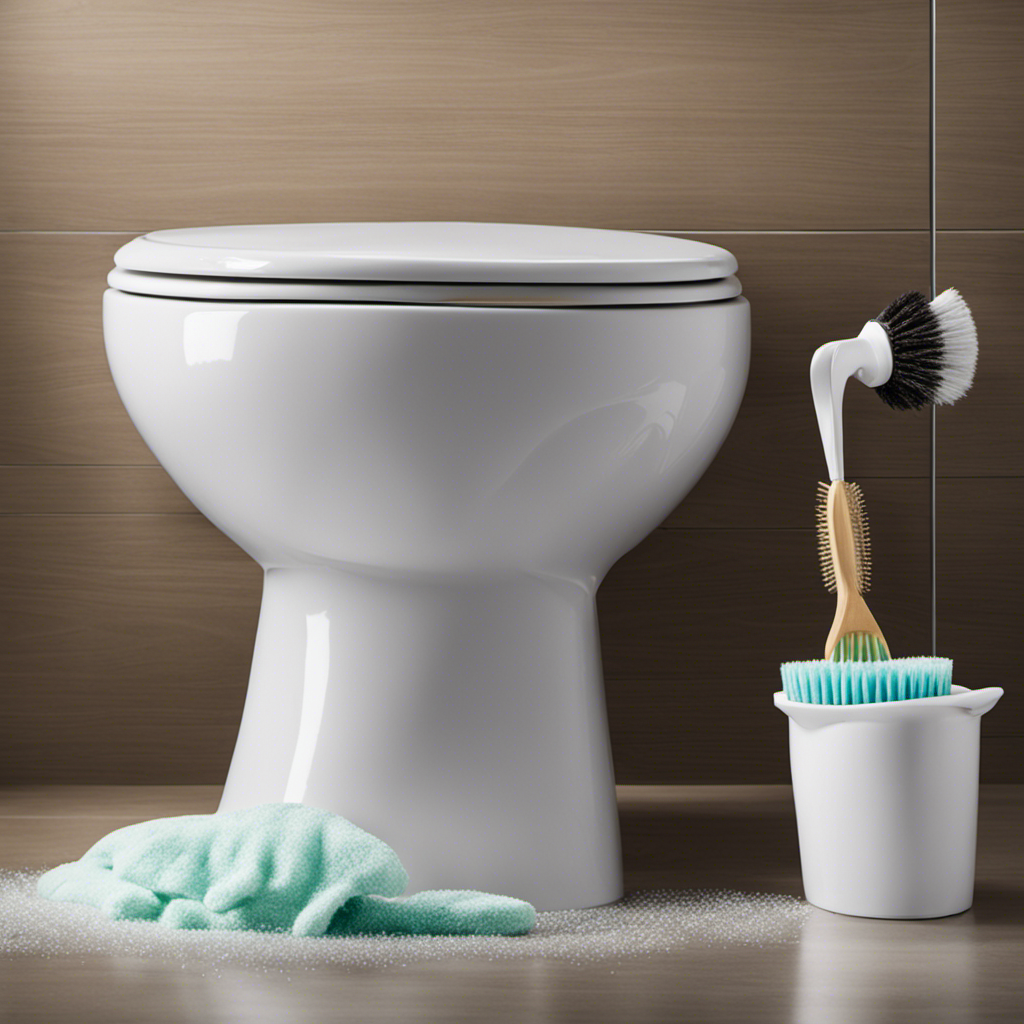Hey there, folks! Have you ever noticed your toilet tank sweating? Well, fear not, because I’ve got just the solution for you.
In this article, I’m going to show you how to stop that annoying condensation from forming on your toilet tank.
We’ll dive into the causes of this pesky problem, assess the severity of the sweating, and explore the right insulation materials to use.
So, let’s get started and bid adieu to those dripping tanks once and for all!
Key Takeaways
- Proper insulation of the toilet tank can prevent condensation and water damage.
- Maintaining a well-ventilated bathroom helps reduce humidity levels and prevent sweating.
- Regular cleaning and maintenance of the bathroom can prevent moisture buildup.
- Monitoring and adjusting the water temperature in the tank can help prevent excessive sweating.
Understanding the Causes of Toilet Tank Sweating
Toilet tank sweating occurs when warm air in the bathroom comes into contact with the cold surfaces of the tank. This phenomenon is caused by condensation, which forms when the warm air holds moisture that condenses on the cooler tank surface.
The impact of humidity plays a significant role in toilet tank sweating. When the air in the bathroom is humid, it contains a higher amount of moisture. This moisture-laden air enters the bathroom and comes into contact with the cold tank, causing condensation to form.
Additionally, activities such as hot showers and baths contribute to increased humidity levels in the bathroom, further exacerbating the issue.
Understanding these causes of condensation and the impact of humidity is crucial in finding effective solutions to stop toilet tank sweating.
Assessing the Level of Toilet Tank Sweating
To assess how much your tank sweats, you can feel the exterior surface for any signs of moisture. Evaluating the effectiveness of your current insulation methods is crucial in troubleshooting issues with toilet tank sweating. Here are some factors to consider:
- Insulation quality: Check if your tank is properly insulated to prevent condensation.
- Ventilation: Ensure that the bathroom is well-ventilated to reduce humidity levels.
- Tank temperature: Monitor the temperature of the water in the tank to prevent excessive sweating.
- Ambient temperature: Evaluate the temperature of the surrounding area to determine if it contributes to the sweating issue.
Choosing the Right Insulation Materials
It’s important to choose the right insulation materials to effectively address the issue of tank sweating. Insulating techniques play a crucial role in controlling the moisture buildup on the toilet tank surface.
When selecting insulation materials, it is vital to consider their ability to resist heat transfer and prevent condensation. Fiberglass insulation, for example, is a popular choice due to its low thermal conductivity and moisture resistance. Another option is foam insulation, which offers excellent moisture control and thermal insulation properties. Additionally, reflective insulation can be used to minimize heat transfer and reduce condensation.
By carefully selecting the appropriate insulation materials, you can effectively combat tank sweating and maintain a dry toilet tank.
Now let’s explore the next step: applying insulation to the toilet tank.
Applying Insulation to the Toilet Tank
To effectively insulate a toilet tank and prevent condensation, there are several methods that can be applied.
One option is to use foam insulation, which provides a barrier against temperature changes and minimizes condensation.
Another method is to apply a reflective insulation material, such as a foil-faced foam board. This helps to reflect heat back into the tank and reduce condensation.
Lastly, using an insulating jacket or wrap specifically designed for toilet tanks can also be an effective way to prevent condensation and maintain a consistent temperature.
Effective Insulation Methods
One effective method for insulating a toilet tank to prevent sweating is by using foam insulation. This technique is widely used in the industry due to its excellent insulating properties and moisture control capabilities. Foam insulation creates a barrier between the cold water inside the tank and the warm, humid air outside, preventing condensation from forming.
Here are four reasons why foam insulation is a superior choice for toilet tank insulation:
- Superior insulation: Foam insulation provides excellent thermal insulation, reducing heat transfer and preventing the tank from becoming cold enough to cause condensation.
- Easy installation: Foam insulation can be easily applied to the exterior of the toilet tank using adhesive or tape, making it a convenient option for DIY enthusiasts.
- Durable and long-lasting: Foam insulation is resistant to moisture, mold, and mildew, ensuring that it will remain effective for an extended period.
- Cost-effective: Foam insulation is an affordable option for insulating toilet tanks, offering a high return on investment in terms of energy savings and prevention of water damage.
Preventing Condensation on Tank
By using foam insulation, you can effectively prevent condensation from forming on your toilet tank. Condensation on the tank can be a common issue, particularly during hot weather and in humid environments. To help you deal with this problem, here are some tips for reducing toilet tank sweating:
-
Insulate the tank: Apply foam insulation to the exterior of the tank. This will create a barrier between the cold water inside the tank and the warm air outside, preventing condensation from forming.
-
Use a tank liner: Install a tank liner made of insulating materials. This liner will help regulate the temperature inside the tank and reduce the likelihood of condensation.
-
Ventilate the bathroom: Ensure that your bathroom is well-ventilated to reduce humidity levels. Use exhaust fans or open windows to allow for proper airflow and moisture removal.
Table:
| Tips for Reducing Toilet Tank Sweating |
|---|
| 1. Insulate the tank |
| 2. Use a tank liner |
| 3. Ventilate the bathroom |
Additional Strategies to Prevent Toilet Tank Sweating
To further address the issue of toilet tank sweating, there are two key strategies that can be employed: insulating the tank with foam and adjusting the water temperature.
Insulating the tank with foam helps to prevent condensation by providing a barrier between the cold tank surface and the warm, humid air.
Additionally, adjusting the water temperature can help reduce the temperature difference between the tank and the surrounding air, further minimizing the potential for condensation.
Insulating Tank With Foam
Insulating the tank with foam can help prevent sweating. By adding a layer of insulation, you create a barrier that prevents the cold water inside the tank from coming into contact with the warm air outside, thus reducing condensation.
Here are some foam installation tips to ensure effective insulation and reap the benefits of insulating your toilet tank:
- Clean the tank surface thoroughly before applying the foam to ensure proper adhesion.
- Use a foam insulation kit specifically designed for insulating toilet tanks.
- Apply the foam evenly and carefully, ensuring complete coverage.
- Allow the foam to cure according to the manufacturer’s instructions before using the toilet.
Insulating your toilet tank with foam not only prevents unsightly sweating but also helps conserve water by reducing the need for frequent refills. It’s a cost-effective and efficient solution to keep your bathroom dry and comfortable.
Adjusting Water Temperature
Adjusting the water temperature in your toilet can help create a more comfortable experience. To prevent your toilet tank from sweating, it is important to make sure the temperature of the water inside the tank is not too cold. Adjusting the thermostat settings on your water heater can help achieve this.
Ideally, the water temperature in the tank should be set to a level that is slightly warmer than the temperature of the surrounding air. This will help reduce the condensation that causes the tank to sweat. Additionally, using insulation tape around the tank can provide further insulation and prevent temperature fluctuations.
Maintenance Tips to Keep Your Toilet Tank Sweat-Free
One simple way to keep your toilet tank sweat-free is by regularly cleaning the exterior surface. This helps prevent condensation from forming on the tank, which can lead to water damage and mold growth.
Here are a few maintenance tips to keep your toilet tank sweat-free:
-
Insulate the tank: Adding insulation to the inside of the tank can help regulate the temperature and prevent condensation.
-
Check the water temperature: Adjusting the water temperature can also help reduce condensation. Keep it at a moderate level to avoid extreme temperature differences.
-
Use a dehumidifier: Placing a dehumidifier in the bathroom can help reduce moisture levels and prevent condensation.
-
Ventilate the bathroom: Proper ventilation is key to reducing humidity levels in the bathroom. Make sure there is adequate airflow by using exhaust fans or opening windows.
Frequently Asked Questions
How Can I Determine if the Sweating in My Toilet Tank Is Excessive?
To determine if toilet tank sweating is excessive, I check for condensation on the tank surface and surrounding areas. If there is a significant amount, it may indicate a problem. Preventive measures can help reduce sweating.
Can Toilet Tank Sweating Cause Any Damage to the Bathroom Floor or Walls?
Toilet tank sweating can potentially cause damage to the bathroom floor or walls. It’s important to address this issue by preventing toilet tank condensation.
Are There Any Alternative Methods to Insulate the Toilet Tank Besides Using Insulation Materials?
There are alternative methods to insulate a toilet tank without using insulation materials. For example, you can try using a toilet tank liner or applying a waterproof coating to the tank.
Can the Insulation on the Toilet Tank Be Easily Removed if Needed?
Yes, the insulation on the toilet tank can be easily removed if needed. The removal process involves carefully detaching the insulation material. However, it’s important to conduct an effectiveness analysis before deciding to remove the insulation.
What Should I Do if the Toilet Tank Sweating Persists Even After Applying Insulation and Other Preventive Measures?
If the toilet tank sweating persists despite insulation and other preventive measures, I would recommend troubleshooting the issue. Check for any leaks, adjust the water temperature, or consider installing a toilet tank liner.
Conclusion
In conclusion, by understanding the causes of toilet tank sweating and assessing its level, we can effectively combat this issue.
Choosing the right insulation materials and applying them to the tank will provide a long-lasting solution.
Additionally, implementing additional strategies like using a toilet tank liner and adjusting the room’s temperature can further prevent sweating.
Regular maintenance is also crucial to keeping your toilet tank sweat-free.
So, why let your toilet tank continue to sweat when you have the knowledge and tools to stop it?










